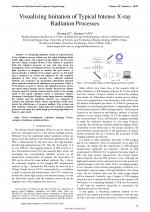| 1/2020 - 3 |
Visualizing Imitation of Typical Intense X-ray Radiation ProcessesLIU, H. |
| Extra paper information in |
| Click to see author's profile in |
| Download PDF |
Author keywords
visualization, radiation imaging, X-rays, computer simulation, radiation effects
References keywords
pinch(6), image(6), array(6), radiation(5), plasma(5), nucl(5), imaging(5), sensors(4), pinches(4)
Blue keywords are present in both the references section and the paper title.
About this article
Date of Publication: 2020-02-28
Volume 20, Issue 1, Year 2020, On page(s): 19 - 26
ISSN: 1582-7445, e-ISSN: 1844-7600
Digital Object Identifier: 10.4316/AECE.2020.01003
Web of Science Accession Number: 000518392600003
SCOPUS ID: 85083719664
Abstract
A visualizing imitation system of typical intense X-ray radiation process which uses the Light Emitting Diode (LED) light source, the Liquid Crystal Display (LCD) panel, and the Charge Coupled Device (CCD) camera is proposed. Both the radiation processes of spot and wire array are investigated. First, two imitation devices are developed. A LED light producer is designed to imitate the spot source. A microcontroller is utilized for its output control. A LCD panel and a raspberry pi circuit are employed for the radiation imitation of wire array. Second, two radiation imitation methods are proposed. An exponential attenuation function and a particle system-based simulation are proposed. Third, a CCD camera is used to observe the imitation devices above, and many image datasets can be created. Because the shutter response speed of normal camera cannot reach to the change speed of the actual radiation source, a time-lapse capture technique is developed. Finally, some image features, including the statistic and the geometric metrics, are computed to evaluate the imitation effect. Many experiment results have shown the effectiveness of propose method. This system can help radiation researcher understand the transient radiation processes and study the initial image processing algorithms for them to some extent. |
| References | | | Cited By |
Web of Science® Times Cited: 1 [View]
View record in Web of Science® [View]
View Related Records® [View]
Updated 3 weeks, 5 days ago
SCOPUS® Times Cited: 1
View record in SCOPUS® [Free preview]
View citations in SCOPUS® [Free preview]
[1] Development of a Picosecond Ultraviolet Light Source for Transient Radiation Time Response Testing of High-speed Cameras, Wang, Lirong, Zhang, Ling, Feng, Jingcheng, Liu, Haoting, Li, Haiguang, Guo, Zhenhui, Zhao, Hui, Li, Qing, Zhang, Guochun, Proceedings of the 2024 3rd International Symposium on Intelligent Unmanned Systems and Artificial Intelligence, ISBN 9798400710025, 2024.
Digital Object Identifier: 10.1145/3669721.3670855 [CrossRef]
Disclaimer: All information displayed above was retrieved by using remote connections to respective databases. For the best user experience, we update all data by using background processes, and use caches in order to reduce the load on the servers we retrieve the information from. As we have no control on the availability of the database servers and sometimes the Internet connectivity may be affected, we do not guarantee the information is correct or complete. For the most accurate data, please always consult the database sites directly. Some external links require authentication or an institutional subscription.
Web of Science® is a registered trademark of Clarivate Analytics, Scopus® is a registered trademark of Elsevier B.V., other product names, company names, brand names, trademarks and logos are the property of their respective owners.
Faculty of Electrical Engineering and Computer Science
Stefan cel Mare University of Suceava, Romania
All rights reserved: Advances in Electrical and Computer Engineering is a registered trademark of the Stefan cel Mare University of Suceava. No part of this publication may be reproduced, stored in a retrieval system, photocopied, recorded or archived, without the written permission from the Editor. When authors submit their papers for publication, they agree that the copyright for their article be transferred to the Faculty of Electrical Engineering and Computer Science, Stefan cel Mare University of Suceava, Romania, if and only if the articles are accepted for publication. The copyright covers the exclusive rights to reproduce and distribute the article, including reprints and translations.
Permission for other use: The copyright owner's consent does not extend to copying for general distribution, for promotion, for creating new works, or for resale. Specific written permission must be obtained from the Editor for such copying. Direct linking to files hosted on this website is strictly prohibited.
Disclaimer: Whilst every effort is made by the publishers and editorial board to see that no inaccurate or misleading data, opinions or statements appear in this journal, they wish to make it clear that all information and opinions formulated in the articles, as well as linguistic accuracy, are the sole responsibility of the author.



